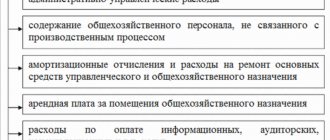Account 04 of accounting is an active account “Intangible assets”, it is used to reflect the movement of certain non-current assets: intangible assets, R&D, technological work.
The above non-current assets can be capitalized to account 04 if:
- The asset will provide future economic benefits;
- The organization has rights to this asset;
- It is possible to identify a specific asset from other assets;
- It is planned to use the asset for more than a year;
- There are no plans to sell the asset during the first year of use;
- The actual value of an asset can be determined;
- Lack of tangible form of the asset.
It is important to note that all of the above must be done at the same time.
Requirements for intangible assets
In order for property to be classified as intangible assets, it must meet a number of criteria:
- have properties that are inherent in fixed assets (operation for at least a year in order to make a profit, the ability to isolate an object and determine its market value);
- have no physical form.
Equally important is the existence of rights to property - the company must, if necessary, confirm this right with relevant documents.
Based on the above, the following objects can be classified as intangible assets:
- literary, musical and other works;
- all kinds of inventions and prototypes;
- computer software;
- trademarks and service marks;
- Database;
- other objects listed in the list of PBU 14/2007.
Business reputation is also part of the intangible assets. It is defined as the difference between the purchase price and the book value of the company, which means it can be either positive or negative.
The following cannot be classified as intangible assets:
- unregistered intangible assets, utility models and patents;
- scientific work for which the results are negative, unfinished or improperly prepared;
- financial objects, the purpose of acquisition of which is to obtain profit from transfer to third parties for use.
Transfer of special equipment into operation
If the cost of special clothing is completely written off when issued to employees, then the cost of special equipment can be written off in three ways:
- proportional to production output;
- straight-line write-off method;
- once in full amount upon commissioning.
The write-off method is configured in the “Purpose of Use” directory. Read on to find out how to do this.
Step 1. Fill out the “Special Equipment” tab in the “Decommissioning of Materials” document
In 1C 8.3, special equipment, as well as special clothing, is transferred to production using the document “Writing off materials for use.” How to create a document and fill out its basic details is described in step 1 of the previous section. To transfer special equipment to production, the “Special equipment” tab (1) is provided. In this tab, click the “Add” button (2). In the “Nomenclature” field (3), select the equipment for commissioning from the nomenclature directory. In the “Quantity” field (4) indicate the quantity of equipment to be transferred.
Step 2. Set up the “Purpose of Use” directory to account for the write-off of special equipment
As we wrote earlier, there are three ways to write off the cost of special equipment. The write-off method is configured in the “Purpose of use” field (1). Click button (2) to configure the payment method. The “Use Purpose” settings window will open.
In this window, in the “Repayment method” field (3), select one of three methods, for example “Linear”. In the “Useful life (in months)” (4) field, indicate how many months the cost will be repaid with a straight-line write-off. In the method of recording expenses (5), indicate the write-off account, for example, 20.01. To save the setting, click “Save and close” (6).
Step 3. Reflect in accounting the transfer of special equipment into operation
The “Account Account” (1) and “Transfer Account” (2) fields in the “Special Equipment” tab will be filled in automatically. To complete the transfer of special equipment to production, click the “Record” (3) and “Pass” (4) buttons. Now in the accounting records there are entries for the transfer of special equipment into operation. Press the “DtKt” button (5) to check the wiring. The posting window will open.
The postings show that account 10.11.2 “Special equipment in operation” reflects its movement upon transfer to the workshop (6) and the write-off of its value as expenses (7). In our example, the linear cost repayment method is established. Therefore, in accounting, the amount is repaid through depreciation when the “Month Closing” operation is launched. In tax accounting, the amount is repaid immediately (8). The write-off is reflected in the debit of account 20.01 “Main production” (9). On a special account MTs.03 “Special equipment in operation” (10) in 1C 8.3, equipment records are kept for each department. If the equipment has become unusable, write it off from this account using the document “Write-off of materials from use.”
Rules for accounting for intangible assets
Information on account 04 consists of the cost of all inventory items recorded on the balance sheet (at initial or actual cost). The account is active: receipts are reflected as a debit, and write-offs as a credit.
Objects are accepted for accounting through account 08 “Investments in non-current assets”. At this stage, the initial cost of the asset is formed and it is debited to account 04 immediately after it is ready for operation. This happens after checking the object for compliance with all the requirements prescribed in the PBU for intangible assets (link above).
Transfer of special clothing into service
Step 1. Create in 1C 8.3 the document “Decommissioning of materials into operation”
Go to the “Warehouse” section (1) and click on the “Transfer of materials for operation” link (2). A window for generating a document will open.
In the window that opens, click the “Create” button (3). A document will open for you to fill out.
In the form to fill out, please indicate:
- your organization (4);
- transfer date (5);
- warehouse from which work clothes are written off (6);
- department to which special clothing is transferred (7).
MOVING FROM “1C” TO “BUKHSOFT” Transferring data from your “1C” is now easy! BukhSoft transfers all data without loss and checks it!
Step 2. Fill out the “Workwear” tab in the document “Decommissioning of materials”
In the “Workwear” tab (1), click the “Add” button (2). In the “Nomenclature” field (3), select the required workwear from the nomenclature directory. Next, fill in the fields:
- "Quantity" (4). Indicate the quantity of protective clothing to be transferred;
- "Individual" (5). Select the employee to whom the workwear is transferred;
- “Purpose of use” (6). Here, specify the accounting parameters for writing off workwear. Use the cost repayment method “Repay the cost upon transfer into operation.” In the method of recording expenses, indicate the write-off account, for example “01/20”.
The “Account Account” (7) and “Transfer Account” (8) fields will be filled in automatically. To complete the operation, click the “Record” (9) and “Pass” (10) buttons. Now in the accounting records there are entries for the transfer of special clothing into operation.
Click the “DtKt” button (11) to view the accounting entries for this operation.
The entries show that account 10.11.1 “Special clothing in use” reflects the transfer of special clothing (12) and the write-off of its cost as expenses (13). The write-off is reflected in the debit of account 20.01 “Main production” (14). On the special account MTs.02 “Workwear in use” (15) in 1C 8.3, records of workwear are kept for each employee to whom one was issued. If the workwear has become unusable, write it off from this account using the document “Write-off of materials from use.”
Subaccounts used
The Instructions to the Chart of Accounts do not specify specific subaccounts for use by the organization. It states only what the analyst needs to conduct in the context of property categories.
Companies prepare a working chart of accounts every year. Account 04 is relevant for universities, design, engineering, and research organizations. In small businesses, account 04 does not occupy a dominant position, since such organizations own a small number of intangible assets.
Transfer of equipment and household supplies into operation
Step 1. Fill out the “Inventory and Household Supplies” tab in the “Materials Write-off for Operation” document
In 1C 8.3, household equipment, as well as workwear, is transferred in the document “Writing off materials for use.” How to create a document and fill out its basic details is written in step 1 of the section “Transferring workwear into operation.” To transfer household equipment, the “Inventory and Household Supplies” tab (1) is provided. In this tab, click the “Add” button (2). Next, fill in the fields:
- "Nomenclature" (3). Select the required inventory from the item directory;
- "Quantity" (4). Indicate the quantity of transferred inventory;
- “Individual” (5). Select an employee responsible for storing inventory;
- “Method of recording expenses” (6). In this directory, choose a method for recording expenses, which indicates an account for writing off the cost of inventory as expenses, for example, account 25.
The “Account” field (7) will be filled in automatically. To complete the operation, click the “Record” (8) and “Pass” (9) buttons. Now in accounting there are entries for the transfer of inventory into operation.
Click the “DtKt” button (10) to view the accounting entries for this operation.
The entries show that the write-off of the cost of inventory is reflected in the debit of account 25 “General production expenses” (11). On a special account MTs.04 “Inventory and household supplies in operation” (12) in 1C 8.3, inventory is kept track of the employees to whom it is issued. If the inventory has become unusable, write it off from this account using the document “Write-off of materials from use.”
Basic operations for accounting for intangible assets
In order for intangible assets to be displayed correctly on the balance sheet, you need to be able to properly organize their accounting. This is done using three basic operations:
- acceptance for registration;
- sale;
- depreciation.
All these transactions must be reflected in the company's accounting policies. Let's look at each operation in more detail.
Acceptance of intangible assets for registration
Intangible assets can be registered through purchase, creation with one’s own hands, receipt as a gift, or during discovery during inventory. As mentioned earlier, an object is accepted for accounting through account 08.
To account for intangible assets, the following entries are made:
- Dt 08, Kt 60 – purchase costs are reflected;
- Dt 02, Kt 10 / 70 / 69 – expenses for materials for creating the object are reflected;
- Dt 19, Kt 60 – VAT is included;
- Dt 04, kt 08 – the actual cost is formed.
Sale of intangible assets
During the sale of intangible assets, its residual value is calculated. As a result, the book price is reduced by the amount of depreciation. The following transactions are made:
- Dt 62, Kt 91 – the sale is reflected;
- Dt 91, Kt 68 – VAT is allocated;
- Dt 05, Kt 04 – depreciation is written off;
- Dt 91, Kt 04 – the residual value is written off.
Property that was acquired for subsequent sale cannot be classified as non-current assets. This also applies to objects that do not have a material form.
Liquidation of intangible assets
The liquidation of intangible assets is documented using the same transactions as for the liquidation of other non-current assets. The only difference is the use of account 04:
- Dt 91 Kt 04 – writing off the residual value of intangible assets for other expenses.
In case of complete liquidation, the residual value is zero.
Thus, in order to correctly reflect intangible assets on the account and in the financial statements, it is important to understand whether the object belongs to intangible assets and how to register it correctly. If you know all the basic nuances, there will be no problems with taking into account intangible assets.
Chart of accounts. Account 004 “Goods accepted for commission”
Feedback from seminar participants:
“The topic of planning and budgeting is covered quite fully. It was interesting to independently prepare a forecast profit and loss report and especially a forecast balance sheet,” Vladimir Breslavsky, Deputy Director for Economics and Finance, Mnogovershinnoe CJSC, Khabarovsk Territory.
“The treasury operating system is described briefly and in detail. Very good teacher, thank you very much,” - Svetlana Sergeevna Bolotova, treasurer, Akado, Moscow.
“The very idea of a seminar on pricing is good - considering it in the complex of marketing and finance. I liked the logic of the presentation of the material, the connection between theory and practice (examples and problems), and the accessible explanation,” Anna Evgenievna Inberg, sales manager, Visteon Avtopribor Electronics LLC, Vladimir.
“The seminar fully met our expectations. The knowledge gained will help you understand financial and accounting statements and see the necessary numbers in a sea of information. I also learned a lot about financial analysis. activities,” Natalya Valentinovna Nikonova, project manager of the communications department of X5 Retail Group, Moscow.
“I liked the coverage of issues related to organizing internal control through management accounting,” Yu.A. Romanyuk, head of the control and audit service of Akson LLC, Kostroma.
“What I liked about the seminar was its practical focus on creating an accounts receivable management system. A large number of practical tools to improve money collection were considered. There are many examples from real practice, which makes it possible to apply the acquired knowledge in your future work. Thank you!" — Kuzminich Andrey Viktorovich, Commercial controller of Modern Machinery Far East LLC, Magadan.
“Structured knowledge on all treasury functions in an accessible form,” Nesterov E.V., Ch. specialist, Rosatom, Moscow.
“After listening to the seminar, I have a general picture of budgeting, which was the goal. All questions that arose were explained immediately. Lots of practical tasks. I wish prosperity to the Alpha Business School,” Natalya Vladimirovna Baklykova, leading specialist at GPN-Logistics, Moscow.
“I liked everything very much! I came for the second time, I was at a seminar on a different topic. The material is presented in great detail, everything is clear based on examples. It was possible to analyze my own enterprise, since there were few participants and it turned out to be an almost individual lesson. Thank you!" — Valeria Vladimirovna Kuksova, economist, Stroystandart LLC, Moscow.
Other reviews on seminar areas >>>
Transactions with off-balance sheet accounts
In addition to the main functions of each position, complex operations are also carried out, where several subaccounts are involved in postings at once. For off-balance sheet accounts, accounting activities are carried out in the following areas:
- Reserve fund. For example, cash notes, coins.
- Obligations and guarantees of borrowers.
- Consumables.
- Settlement documentation.
- Accounting for material assets accepted for storage.
- Leased and leased fixed assets.
- Debt write-off.
Three main subgroups
There is no correspondence with the balance, as well as between subaccounts.
Off-balance sheet account 01 in budget accounting
Used to account for fixed assets (fixed assets) received under lease agreements or free of charge with the right to operate without being assigned to operational management.
Let's look at a practical example.
For the celebration, the cultural institution rented costumes. According to the contract, the lessor gave 5 suits for two-month use. The rent amount was 12,500 rubles. After the holiday, the costumes were returned. Off-balance sheet account 01 was used in accounting:
- property objects were received for rent - Dt 01 (RUB 12,500);
- the leased property was returned - Kt 01 (RUB 12,500).
The basis for the operations was the lease agreement and the acceptance certificate.
VAT on commission fees
Intermediary services in Russia are recognized as subject to VAT at a standard rate of 18%. The commission agent's fee is considered his income from ordinary activities. The commission agent's profit is calculated as the difference between the amount of the fee under the commission agreement minus VAT and the costs of selling the tenant's property.
The amount of remuneration becomes the starting point when calculating the commission agent’s income tax and the basis for calculating VAT.
VAT will not be charged on the commission agent’s income if his earnings consist of tax-free activities:
- folk art products crafts with recognized value (except for excisable goods);
- ritual services and funeral items (according to a closed list);
- medicines (the list is closed);
- leasing space to foreigners and foreign companies that have been accredited in the Russian Federation.
The taxable base for VAT is the difference between the money received as a fee under a commission agreement and the costs of its implementation. All money accepted from the employer and used in the transaction is not included either in the expenses or in the income of the commission agent.
When a commission agent sells the property of a principal, he draws up an invoice for the customer on his own behalf within 5 days, then informs the principal of his details and accepts an invoice from him with the same data. An accepted invoice is subject to registration in Part 2 of the register of received and issued invoices and is not recorded in the purchase book.
For the fee for the provision of intermediary services, the commission agent issues an invoice to the principal, which is subject to registration in Part 1 of the log of received and issued invoices and in the sales book.
What subaccounts are opened for account 08
The chart of accounts suggests opening the following subaccounts for account 08, which we have collected in the table.
| Subaccount | We use it for accounting |
| 08.1 | Here we collect all the costs associated with the purchase of a land plot: from the cost of its acquisition to registration fees. |
| 08.2 | Here we summarize all the costs associated with the purchase of environmental management facilities. |
| 08.3 | Here we accumulate all the costs associated with creating an OS yourself. For example, these are the costs of constructing buildings and installing equipment. |
| 08.4 | We take into account all costs associated with the purchase of machines and equipment that do not require installation. |
| 08.5 | Here we reflect the cost of purchased intangible assets. These could be licenses for computer programs, trademarks, and so on. |
| 08.6 | Here we record all the costs incurred by the company for raising young animals. |
| 08.7 | Here we reflect the cost of purchased adult animals, including their delivery. |
| 08.8 | Here we reflect the company's R&D costs. For example, the creation of a new technology or prototype. |
Off-balance sheet account 07 in budget accounting
It records two types of MCs:
- prizes, cups, banners intended to reward the winners throughout the entire period of their stay in the budget organization according to conditional assessment;
- souvenirs and valuable gifts at the cost of their acquisition.
Let's look at a practical example.
The sports institution purchased valuable gifts to be used as prizes for competition winners for RUB 26,500. Based on the results of the competition, the athletes received gifts. Transactions on their purchase and delivery should be reflected as follows:
- acquisition costs – Dt 4,401 10,290 Kt 4,302 29,000 (RUB 26,500);
- cost of valuables on the balance sheet – Dt 07 (RUB 26,500);
- payment for purchased MCs for gifts – Dt 4,302 29,000 Kt 4,201 11,000 (RUB 26,500);
- debiting donated prizes from the off-balance account – Kt 07 (RUB 26,500).
Purchase by a commission agent of goods for the principal
There are no clear standards for an accounting employee to make entries under an agreement for the purchase of goods on behalf of the principal; the rules are approved within the company. Since the commission agent acts on behalf of the employer and uses his money in the process of working under a commission agreement, all cash receipts and expenses belong to the latter, so these transactions will be reflected in the accounting book. principal's registers.
When purchasing goods for the consignor, the intermediary issues an invoice in 2 copies and enters information from the supplier’s accounts into it.
Accounting with a commission agent without participation in calculations
Debit 76 Credit 51 – expenses incurred by the commission agent at the expense of the principal were paid.
Debit 76 of the account “Settlements with the principal” Credit 76 – reflects the debt of the principal for expenses.
Debit 76 s/ac “Settlements with the principal” Credit 90 – the commission agent’s remuneration has been accrued.
Debit 90 Credit 68 – VAT is charged on the commission agent’s remuneration.
Debit 51 Credit 76 s/ac “Settlements with the principal” – compensation for expenses and commission agent’s remuneration received in the current account.
Off-balance sheet account 04 in a budget institution
Budgetary organizations can write off debts recognized as unrealistic for collection, reflecting them on the balance sheet. To account for this type of debt, off-balance sheet account 04 written off debt of insolvent debtors is used (clause 339 of Instruction No. 157n). It is necessary to monitor the possibility of debt repayment. If collection resumes or funds are received to repay the debt, the debt is written off.
Let's look at a practical example.
Limitation period for debt in the amount of RUB 4,570. expires on November 25, 2017. By order of the director, it must be written off on the basis of documents confirming the recognition of the debtor as insolvent. The following entries must be made in accounting using off-balance sheet account 04:
- write-off of debt recognized as unrealistic for collection - Dt 2,401 20,273 Kt 2,206 31,000 (RUB 4,570);
- simultaneously accounting for debt on the balance sheet - Dt 04 (RUB 4,570);
- account closure – Dt 2,401 30,000 Kt 2,401 20,273 (RUB 4,570).
Let's say that in December 2021, the debtor returned the money given to him in advance for the supply of materials. The debt should be restored as follows:
- restoration of debt on accounts – Dt 2,401 20,273 Kt 2,206 31,000 (RUB 4,570);
- simultaneously writing off debt – Kt 04 (RUB 4,570)
Sales by a commission agent of the principal's goods
Costs for the sale of goods of the principal are not considered as expenses of the intermediary and are reflected only in the accounting of the intermediary. Transactions can be carried out with or without the participation of the commission agent in the calculations.
| The commission agent participates in settlements | The commission agent does not participate in settlements |
| 1. Money for the sold goods goes to the intermediary’s cash desk or to his current account; | 1. Funds from the buyer are transferred directly to the principal’s account; |
| 2. From this money, the commission agent retains a fee, the amount of which should not exceed the amount promised by the employer; | 2. When the principal receives the proceeds, he pays the commission agent his remuneration for the work done. |
| 3. The remaining funds are sent to the account of the consignor, the owner of the items sold. | |
| Postings: – D 004 (tenant’s property is included in the balance sheet) – D 51(50) K 62 (proceeds from the sale of entrusted property are taken into account) – D 62 K 76 sub. “Settlements with the principal” (sale of his property by an intermediary) – K 004 (goods delivered to the buyer) – D 76 K 51 (costs of the commission agent are reimbursed) – D 76 Sat. “Settlements with the principal” K 76 (debt of the employer for the costs of the intermediary) – D 76 Sat. “Settlements with the principal” K 90 (intermediation fee accepted) – D 90 K 68 (VAT is calculated from its amount) – D 76 Sat. “Settlements with the principal” K 51 (the principal receives money from sales minus the intermediary’s remuneration and the amount of reimbursement of his expenses) | Postings: – D 76 K 51 (payment of commission agent’s expenses from the employer’s money) – D 76 Sat. “Settlements with the principal” K 76 (the debt of the principal for expenses is indicated) – D 76 Sat. “Settlements with the principal” K 90 (remuneration for intermediary services accepted) – D 90 K 68 (VAT is determined on its amount) – D 51 K 76 sub. “Settlements with the principal” (remuneration and compensation for losses are transferred to the account) |








